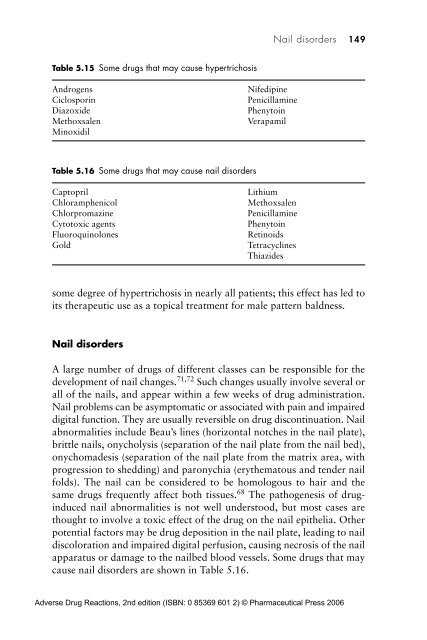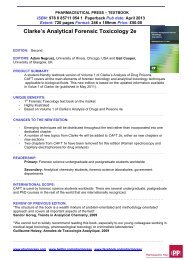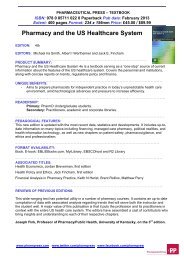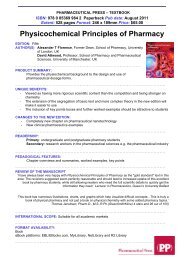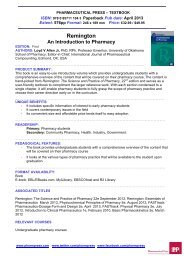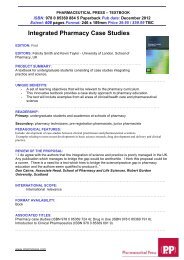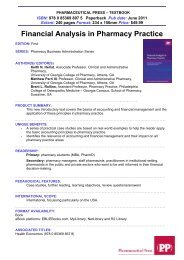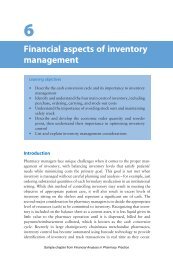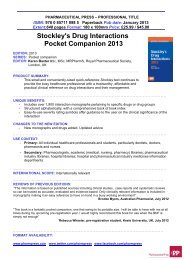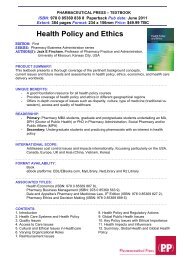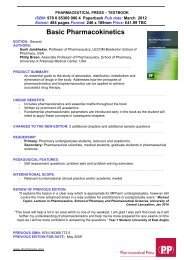Drug-induced skin reactions - Pharmaceutical Press
Drug-induced skin reactions - Pharmaceutical Press
Drug-induced skin reactions - Pharmaceutical Press
Create successful ePaper yourself
Turn your PDF publications into a flip-book with our unique Google optimized e-Paper software.
Nail disorders 149<br />
Table 5.15 Some drugs that may cause hypertrichosis<br />
Androgens<br />
Ciclosporin<br />
Diazoxide<br />
Methoxsalen<br />
Minoxidil<br />
Nifedipine<br />
Penicillamine<br />
Phenytoin<br />
Verapamil<br />
Table 5.16 Some drugs that may cause nail disorders<br />
Captopril<br />
Chloramphenicol<br />
Chlorpromazine<br />
Cytotoxic agents<br />
Fluoroquinolones<br />
Gold<br />
Lithium<br />
Methoxsalen<br />
Penicillamine<br />
Phenytoin<br />
Retinoids<br />
Tetracyclines<br />
Thiazides<br />
some degree of hypertrichosis in nearly all patients; this effect has led to<br />
its therapeutic use as a topical treatment for male pattern baldness.<br />
Nail disorders<br />
A large number of drugs of different classes can be responsible for the<br />
development of nail changes. 71,72 Such changes usually involve several or<br />
all of the nails, and appear within a few weeks of drug administration.<br />
Nail problems can be asymptomatic or associated with pain and impaired<br />
digital function. They are usually reversible on drug discontinuation. Nail<br />
abnormalities include Beau’s lines (horizontal notches in the nail plate),<br />
brittle nails, onycholysis (separation of the nail plate from the nail bed),<br />
onychomadesis (separation of the nail plate from the matrix area, with<br />
progression to shedding) and paronychia (erythematous and tender nail<br />
folds). The nail can be considered to be homologous to hair and the<br />
same drugs frequently affect both tissues. 68 The pathogenesis of drug<strong>induced</strong><br />
nail abnormalities is not well understood, but most cases are<br />
thought to involve a toxic effect of the drug on the nail epithelia. Other<br />
potential factors may be drug deposition in the nail plate, leading to nail<br />
discoloration and impaired digital perfusion, causing necrosis of the nail<br />
apparatus or damage to the nailbed blood vessels. Some drugs that may<br />
cause nail disorders are shown in Table 5.16.<br />
Adverse <strong>Drug</strong> Reactions, 2nd edition (ISBN: 0 85369 601 2) © <strong>Pharmaceutical</strong> <strong>Press</strong> 2006


